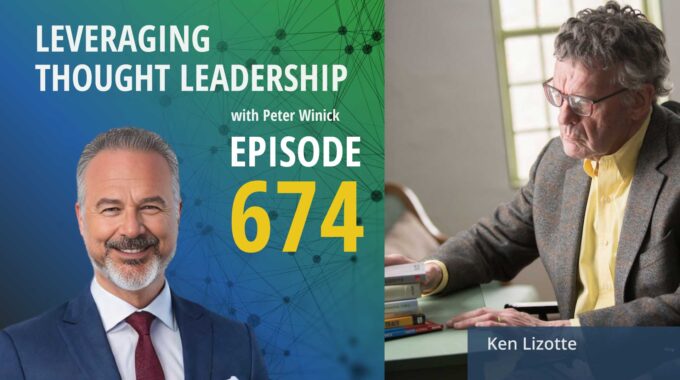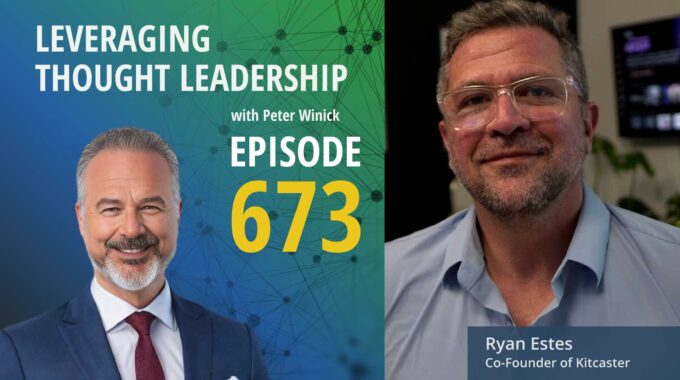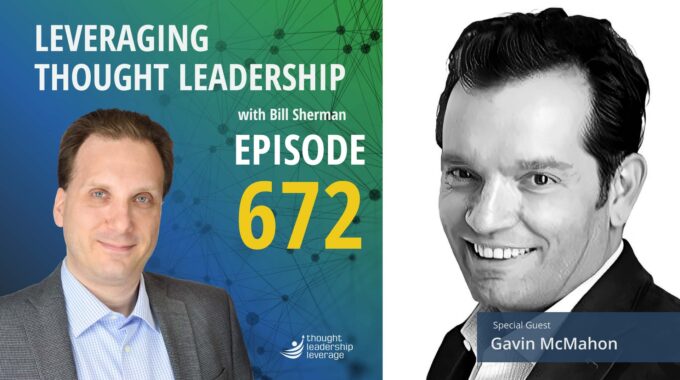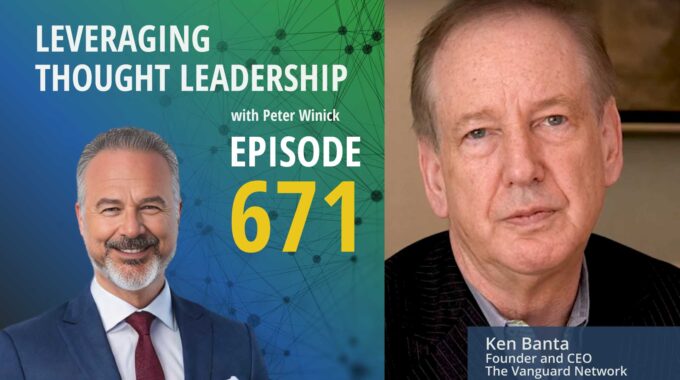Why Great Thought Leaders Don’t Play the Publisher’s Game Peter talks with publishing expert Ken…
Simplifying Complex Ideas Using Thought Leadership | Jeffrey Wheatman
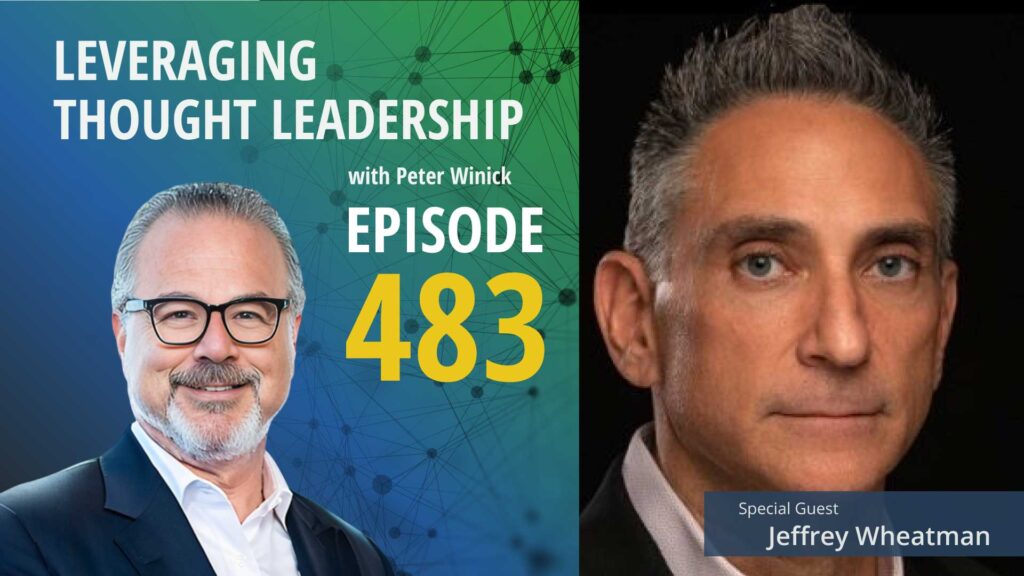
How thought leadership can spread technical ideas to an under-informed audience.
An interview with Jeffrey Wheatman using thought leadership to express the importance of cyber security.
Cyber risk and cyber security are very important but there are also a lot of people in that space. So how can thought leadership elevates you above the others in that space in a way that connects with a larger audience?
Today our guest is Jeffrey Wheatman, Cyber Risk Evangelist for Black Kite, a company that is disrupting traditional third party risk management practices worldwide by providing cyber security experts with greater visibility.
While the topics that Jeffrey talks about are of the utmost importance to most businesses, many just don’t have the technical knowledge to understand why they are important. Jeffrey explains that by using thought leadership he is able to convey these complex ideas in a language that business will care about and in a context they can clearly understand the threats that exist to their business.
Part of his thought leadership includes speaking at conferences and other events. Jeffrey shares why he speaks about topics such as executives who don’t understand IT and understanding risk in 3rd party ecosystems instead of the services that Black Kite offers. By speaking to the issues in an authentic way he is able to build a relationship and get potential clients thinking of what they need to solve the presented problems, which ultimate sleds them back to him and eventually the services he offers.
In addition to speaking Jeffrey uses LinkedIn to spread his thought leadership message. He discusses his target of posting at least once a day and how he judges the success of each post. He also talks about why it is important to take part in the discussions others are having, offering support and why it’s alright to be contrary to the original idea.
Three Key Takeaways:
- You need to find and embrace your own voice with its quarks because that is what attracts people to it.
- Thought leadership comes down to being able to say something short, pithy, and that makes people lean in and say “I’ve never thought about that before”.
- You need to take what you know and compartmentalize it and share it in a way that it land with the largest audiences
If you need a strategy to bring your thought leadership to market, Thought Leadership Leverage can assist you! Contact us for more information. In addition, we can help you implement marketing, research, and sales. Let us help you so you can devote yourself to what you do best.

Transcript
Peter Winick And welcome, welcome, welcome. This is Peter Winick. I’m the founder and CEO at Thought Leadership Leverage and you are joining us on the podcast today, which is Leveraging Thought Leadership today. My guest is Jeff Wheatman. He’s a cyber risk evangelist, so he is regarded as a foremost expert in guiding public sector clients and Fortune 500 companies in connection with their cyber risk, which is obviously a big deal today. There’s a whole bunch of other interesting things in his bio that I’m going to ignore because he’s sitting here and I’d rather just talk to him. So, Hey, Jeff, how are you?
Jeff Wheatman I am doing well. Peter, Thank you so much for having me. Yeah, somebody else wrote my bio. It’s all true, but they definitely make everything look much more interesting than it has been delivered, frankly.
Peter Winick Right. You should. You should read it. You probably be impressed with yourself.
Jeff Wheatman You know what? My wife wrote it for me. I’m sure I sound very impressive.
Peter Winick There you go. So let me ask this. So, you know, cyber is big, cyber risk is big, cybersecurity is big, etc., etc.. And sort of snarkily, I’ll say so what? Right. You know, meaning from a thought leadership perspective, because there’s lots of people doing what you do and it’s a market that’s growing and all that. Let’s take this down, this sort of path of thought leadership. How are you and have you and do you plan to effectively use thought leadership to stand out from the crowd?
Jeff Wheatman Yeah, so it’s a great question. It’s actually been a core of what I’ve really been doing for for a long time. And I think a lot of it is we have to take the things that happen and that we do in cyber and in third party risk in this sort of all these landscape. And we need to turn that into language that the business cares about, right? In a nutshell, business executives care about three things money coming in, money going out. And if something bad happens, who’s going to take the blame for that? I think all the things within cybersecurity and sort of contextualize that. So like as a very quick example, we know ransomware is a big problem. We know that where in your third party ecosystem, your supply chain is a big problem. But if you go to these folks and say, Hey, we are worried about ransomware in our suppliers, they go and whatever. But if you go to them and say, look, if they get hit with ransomware, they’re down for a week based on what our business executives are telling us, we’re down for two weeks. You folks okay with that? And generally they’re not going to be okay with that. So then we can start to have that business anchor discussion rather than a bunch of technical people, stuff that most people don’t care about, frankly.
Peter Winick So how are you and the organization using thought leadership? And let’s sort of map the use of thought leadership against sort of maybe traditional sales pipeline, you know, awareness, a prospect qualifying. Do you think about it in those terms or how do you what’s your plan?
Jeff Wheatman So it’s interesting you ask that. I don’t think about it in that terms because I’ve never been a sales person. I’ve always been a management consultant kind of resource. So what I always do is I always sort of work backwards and say, okay, so what are your business goals like? What are your hopes, dreams and aspirations? Then let’s talk about what the dependencies are and then we can talk about the potential impact. So as third party risk, expanded ecosystem supply chain risk, as an example, we may be doing a perfect job doing security, but our partners, we don’t know what they’re doing. So we need to understand that so that we can then go to our enterprise risk team, our executive leadership, and help them understand all of this stuff falls together under this big giant risk umbrella. So how do we then go about balancing investment, right. The need to run the business with the need to protect the business? We’re hearing from a lot of executives. I’m sure you’re hearing this, too, that with the economy potentially turning more, who knows Now people are willing to accept more risk. Well, how do we build that in and how do we then go out and you.
Peter Winick Give me a specific example then. So I understand that, but give me a specific example of where thought leadership comes in. Is it you going out at conferences and speaking? Is it original research? Is it writing and commenting? How do people know that you and the firm can punch above your weight because you’re smart by observing the thought leadership that you’re involved in?
Jeff Wheatman Right. So I’m a big believer in focusing on business value and then all the other stuff comes from there. So what I’ve been doing a lot of I just got back from Toronto, I did two presentations at a C, so conference I didn’t talk about it at all. Right? I talked about how you can communicate with executives that don’t know anything about it. I talked about how you can understand where your risk is within your third party ecosystem.
Peter Winick So there for a minute though, because I wanted to dissect a couple of things you said. So you didn’t talk about your company, right? Most people have been trained or think they’ve been trained to say, Oh, if I’m going to. What conference? I’ve got to deliver the infomercial. And my blackout is the greatest company ever. And we have offices here. And here’s our logo page like nobody cares. That’s when people take out their phones during, you know, during your speech or go to the restroom or go grab another cup of coffee. So I love the and this is about trying to get to the thought leadership. You know, how do you effectively communicate to non-technical people like, okay, that’s a universal piece that if you can give someone a nugget or two or three and say, well, this guy gets pretty smart, like I think, oh, by the way, what does he do? Like you almost intentionally bury the lead. And it’s counterintuitive, but it’s more impactful because I’m sure you went to Toronto. How many folks came up after you and said, oh, tell me more. Can we grab a copy? Or how might you help Tons?
Jeff Wheatman And what’s funny? And you nailed it. Someone came up to the booth and said, That was a great talk. I don’t know what you guys do. Can you tell me more? Right. And that was that. That’s the value. And when I came on board here, I told him, I’m not going to go out and be a walking, talking commercial. That’s not what I do. I want to help.
Peter Winick But I would argue that you are I would argue and I just I would argue that you are, but you’re doing it your way. You’re doing it in a more authentic, less. You don’t feel like I need to take a shower, kind of like I want to share great ideas and thinking with this population that can be helpful. And I know good things will happen, right? Like it’s not, you know, rainbows and unicorns. You’re in front of the right group giving the right message to get people to lean in. And I’m sure there are six or eight or ten other presenters that week that were that that weekend at that event. Right. How many of them took the path that you took versus way more so every.
Jeff Wheatman Every other vendor puts a marketing person on stage. Got it. That’s what I love that. Yeah. Again, back to the next one. Yeah, the thought leadership. So here here’s something that I’ve been talking to people about. So people talk about vendor risk management, third party risk management, supply chain risk management. And I said, you know what? It doesn’t matter what you call it, you have risk because you do business with other people. Let’s look at what that risk is and you can call it whatever you want. And it’s getting people to think differently about the problem. We talk to people in the US federal government as an example. They don’t know anything about third party risk management. They know supply chain risk management. But unless you know who’s in the audience and who you’re talking to, there are people public and private where I just came from. So, you know, I think that’s just one small thing. And it’s not even brilliant, right? It’s just let’s take the things we know and compartmentalize them so that it actually makes more sense and lands with the widest range of audience. That’s right. We know good movies are the ones that hit your heart strings, and then maybe there’s some characters. So let’s hit the widest range audience. And to me, that’s where thought leadership comes down to, right? Can you say something short, pithy and easy to understand that makes people go, Hmm, never thought about that before and when it hit the widest range.
Peter Winick If you’re enjoying this episode of Thought Leadership Leverage, please make sure to subscribe. If you’d like to help spread the word about our podcast, please leave a five-star review at ratethispodcast.com/ltl and share it with your friends. We’re available on Apple Podcasts and on all major listening apps as well as at ThoughtLeadershipLeverage.com/podcast.
Peter Winick You know, a conference, an event that you just went to and gave a good example there. Give me examples if you could, of other modalities because that’s one modality, right? There’s lots of other places that those same ideas could live, whether it’s video or blogs or where else do you put your thought leadership out there to get in front of the people that matter to you?
Jeff Wheatman Social media obviously is one of those venues. LinkedIn is really sort of the de facto business one. And I try every day to put out one of my own ideas. And then I also try to comment and support other people’s ideas. So, hey, somebody posted a cool link. Oh, you know what? That’s interesting. Have you thought about this implication?
Peter Winick So let’s see what that other piece because I love that. I love that because most people think, wow, there’s a lot of work. I got to come up with all these ideas. I’ve got to create all this stuff. I’ve got to right, I’ve got this, I’ve got to that. And I think the reality is, if you think about this a little bit differently, if you say, wait a minute, I know who the client base is or the potential client base is that I’m trying to reach and I know who they are and I know what they think and how they think, and I know who else they follow. You can elevate your brand by commenting and people think, really? And it’s like actually some of the more interesting conversations, particularly on LinkedIn, happen underneath the postings. Someone can put up a. And as long as we’re mindful and respectful every now and then, people get stupid. It’s not a place for that. But if you can be really thoughtful in your response, it could be you’re almost hijacking the audience and the value, right, of that engagement. And I think people underestimate because it’s far easier to go in there. Read an article, take 2 to 3 minutes to go. I have an opinion on that. Right.
Jeff Wheatman Well, you know what they say about opinions. Everybody’s got one.
Peter Winick But I have a good opinion that might be valuable to the community that I serve.
Jeff Wheatman Well, but I agree. And I think sometimes your opinion can go counter to the original post. Sure. And it’s okay to do that. To your point, though, you don’t want to get snarky. And yes, unfortunately, I’ve seen a lot of that. You know, people go, oh, this is a dumb idea. Okay, you may be correct, but what’s your idea? That’s better. Right. You can’t just say.
Peter Winick Well, and I think that I think that’s exactly right. I think that you don’t need to just, you know, hey, you know, I think some of the dumbest comments are. That’s awesome. I agree. Wonderful. Okay. That doesn’t show any thought or insight. So whether you agree or not isn’t really the point. If you disagree, do a respectfully and say, actually, you know, I hear what you’re saying so and so whoever wrote this, I have a little bit of a different take and here’s why. So I think X is a better way to handle that because I’ve seen it ABC And that’s a fine way to have, you know, a civil discourse. Remember those remember when a civil discourse was sort of.
Jeff Wheatman Like we have no recollection that those used to exist?
Peter Winick So I love commenting and I love that you also have a target for frequency. I want to put out one new idea, a debt.
Jeff Wheatman Yeah, that’s my target. I to be honest, I don’t always hit it.
Peter Winick Okay.
Jeff Wheatman But we try to get out there and, you know, I know through my career, I’ve met so many people and so many of them have great ideas, and I’m trying to get those ideas share, too. So not even just commenting, but hey, you know, my friend so-and-so just posted this really cool thing. They’re not connected to a lot of people. I am. So instead of everybody hits the light button and that’s great, but.
Peter Winick That’s not that’s kind of lazy.
Jeff Wheatman Yeah, I’ll pass that across and go, Hey, my friend, just put this up. I think it’s really cool. Let’s talk about it. Yeah, that’s valuable as well.
Peter Winick So let’s let me go to a little bit of a different direction. So you’re posting a lot. You know who your audience is so you know what they care about. You’re not posting about. Oh, I just had a great, you know, will perform at a wonderful Italian restaurant last night. Nobody cares. Maybe your friends can’t. Right. How are you evaluating the post that you’ve created to give you insight on what you should do more of and less? Lisa Because I always look at every time I think you have to have a mindset, just my opinion that every time you put something out from a thought leadership perspective other than a book that’s a heavy lift. It’s just an experiment, right? It’s just, you know, some of you, if you’re putting out that quantity of ideas, some of them are going to be crap, and that’s okay. But what how what’s your system and processes to learn from what resonated or resonates from the things you put out in the world?
Jeff Wheatman So it started off very ad hoc, to be honest. But over my SO I’ve been in my role now for ten months. So over that time I’m starting to figure out sort of what works. I think some of it’s a total wild card, though. I posted stuff that I think is nothing and a bunch of people engage and then I yeah, this is the smartest thing I’ve said all year and you get nothing. But I look, you know, I look to see whether other people are commenting, you know, are there any ads there? And then on the back end, I can actually find out from our marketing people who’s clicking through to the website looking me up. But truthfully, Peter, the best way that I see that it’s working is I get people looking at my profile, I get people following me and I get people offering to connect. And that to me is the best judge, right? Because I want to be able to engage with as many people as possible. So, you know, we’re talking about the conference. I got off stage. I had 35 inbound LinkedIn connections as a result of the two presentations I gave as that’s what that means. The message landed and now, well.
Peter Winick In those 38 connections, because of where they originated from, I’ve worried, you know, you’ll get your, your, you know, whatever mother in law’s friends from canasta. Right. These are real valuable connections. So I love I love a lot of what you’re doing in terms of committing to consistency and frequency, knowing who your audience is, multiple modalities. What about you doing anything where you’re collaborating with others that are in this space or tangentially in the space to do things together.
Jeff Wheatman So that’s so the great thing is coming from Gartner for so long, I have a lot of people who I’ve since done what I’ve done, so I’ve actually been doing a lot of work with them. A buddy of mine who I was just up in Toronto, he just changed jobs. He and I are going to do a road show up in Toronto, in Ottawa.
Peter Winick Nice.
Jeff Wheatman I’ve been on a bunch of other podcasts from, you know, former colleagues and. The one thing that I’m working on is trying to figure out what this evangelist job actually is right at its core. I think in I talk, okay, that’s great. But there are a lot of people doing this kind of role and they don’t necessarily have that title. So I’ve actually been reaching out to those people and I’m going to be starting to build a community to say kind of, you know what? What works and what doesn’t. We do a ton of internal collaboration as well at Black, where I write blogs with our chief security officer. I’m actually building a presentation on A.I. and Security with our head of research. So that’s part of what I’m doing. But yeah, but you know, some of the other things too. So a blog is a great example. When I first started, I was dictating my thoughts to one of our writers, the great writer. She’s not me. So I now have started writing my own blog with my voice in my weird sense of humor and my sort of, you know, geeky kind of nerdy core. And it’s definitely resonating much, much more. You know, I try to throw in one reference that someone should ask me, What does that mean? Because I’m trying to you know, you want to get people, people thing. And then we’re also finding.
Peter Winick Finding and embracing your own voice with its quirks and all because that’s what attracts people to it, right. If you’re just the outcome of a chat geeky, you know, whatever. Yeah, I might get the quote information from you, but I’m not getting that emotional resonance and I’m not looking forward to, you know, Wow. Just, you know, people do look forward to it, right? Like, we’ve had clients I don’t know. I don’t get anything out of the thought leadership, but, you know, and then they you’ll see they publish a newsletter every two weeks and they miss it. One week writer And all of a sudden they’re getting a bunch of inbound. What happened? What happened? They like you don’t realize that that people are actually like, looking forward to hear what you have to say.
Jeff Wheatman Yeah well, I have a good friend of mine who’s not even in this field. I’ve known him forever. So all of my blogs close with men out. Right? Which is sort of how did you know Ryan Seacrest? So he sent me a text. He was like, We’ve made out with smiley faces. I had no idea he was reading my blog. He doesn’t do what we do. He’s not in our industry. He runs a plumbing supply warehouse. It’s a great job and it’s important for that. But the fact that he’s even interested in hearing and frankly, I write, he’s not all that interested in hearing me. But I think you’re right. And one of the things is I love like my wife runs her own company. I love what she cross post my stuff, which I’ll ask you to do every once in a while, because then people who never saw that stop in her insecurity start to questions. And that’s the key thing, right? Let’s get people to ask questions and let’s engage. And to me, that’s true thought leadership. It’s not about whether what I say is smart or unique. It’s about whether what I say gets people thinking right and engaging and asking questions and providing their perspective. To me, that’s the value of thought leadership. Everybody can get up on a podium and go, Look how smart I am. You know, as an example, I people refer to me as an expert. I don’t like that. I am an expert practitioner. I know what I know because I’ve made a lot of mistakes.
Peter Winick But if others are referring to you is that it’s one thing for you to stand up and say, I’m an expert because now I’m already thinking jerk, right? But if somebody else sort of bestows that to you, that’s a that’s a signal of respect of acknowledgment on your own horn, Right.
Jeff Wheatman Yeah, I suppose. I think maybe I, like a lot of people have a little bit of imposter syndrome.
Peter Winick So they make it to the club. Yeah.
Jeff Wheatman Yeah, maybe. Maybe that makes me feel uncomfortable for that reason. But I have to learn how to take compliments, frankly. Other people say that was really smart. And I go, okay, but it’s.
Peter Winick Yeah, exactly, exactly. Well, this has been a lot of fun. Yep. I appreciate you sharing some of what you’re doing. Some of it’s working and good stuff. Good stuff. Thank you so much for spending some time with us.
Jeff Wheatman My pleasure. Peter, it was great to get to know you and yeah, thanks for having me. It’s been it’s been a fun way to start off my morning.
Peter Winick To learn more about Thought Leadership Leverage, please visit our website at Thought Leadership Leverage dot com to reach me directly. Feel free to email me at Peter at ThoughtLeadershipLeverage.com and please subscribe to Leveraging Thought Leadership on iTunes or your favorite podcast app to get your weekly episode automatically.


